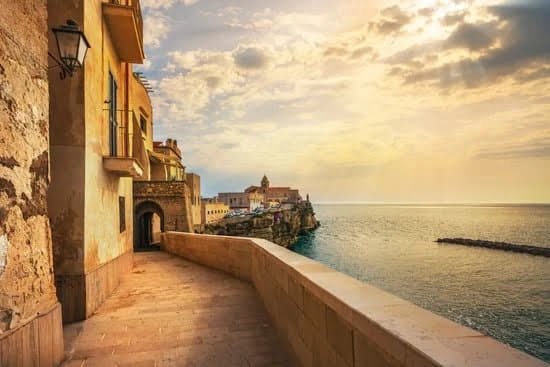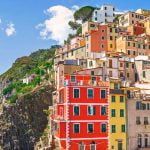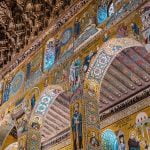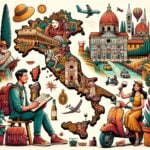
Italys’s history and heritage is made up of many complex chapters. Italy is, in many ways, the crossroads of Mediterranean history and culture. From ancient empires to modern-day nations, Italians have played a fundamental role in modes of expression, ideas, and attitudes that span centuries and peoples. The legacy of Italian history and heritage is an important part of world culture today and remains a captivating source for exploration.
The expansion of Italy’s empire was marked by advancements in art, science, religion, architecture and philosophy. The Roman Empire spread over present-day Rome as its capital city, along with large parts of Europe-and even posed a challenge to the Greeks’ cultural dominance for centuries.
Regional wars transformed into the means to expand its borders to influence entire countries from Slovakia to Spain during its golden age as one of the most significant powers in the world.
During this era, Romans contributed heavily toward advances in literature, engineering systems such as roads and aqueducts, language unification through Latin-as well as founding libraries which still exist today such Memorial Hall Library in Harvard University is a clone of a Roman cantilever library type – and democratizing urban life with its governance system.
Throughout Italy’s political evolution-which included Napoleonic domination leading up to full unification during 1861 – ancient traditions have been passed down from generation to generation. Traditions like la festa, referring to lively local festivals that celebrate religious saints are still common today; food plays an integral part within them incorporating a variety of flavors ranging from pasta al pesto alla Genovese (pasta with basil pesto) or Torrone (nougat) depending on what region you’re visiting.
Attending popular celebrations provide exciting opportunities for learning about cultures often learned through insightful storytelling or hands-on activities such as dancing traditional Tarantella española or playing various games. Touring Europe requires consideration of customs that have evolved throughout adolescence instead abandoned – widespread mutual respect demonstrated within local customs exude genuine hospitality observed throughout the country regardless if you’re passing through small villages tucked away on hilltops or bustling about busy city streets.
In summary, unearthing Italian history provides an abundant treasure chest filled with invaluable reminders adding depth towards understanding our world ‘ s ever changing cultures. For Italians, revisiting their country’s rich past helps make more sense out their rich identity an appreciation for generations prior who laid foundations for the life we experience today.
Exploring Italy reveals how factionalism eventually unified into collective purpose transforming colorful threads spanning centuries into unique gems woven among lasting memories from one ‘ s travels sharing both connections shared humanity endless opportunity forge new paths unexplored amidst awe inspiring views providing compelling insights past present day adventures lead home.
Rich Spiritual Heritage
Italy’s diverse spiritual heritage is that of a country where multiple faiths hold equal respect. The ancient religion of Etruscan, the classical pagan gods of Ancient Rome, and the modern traditions of Catholicism and Islam collectively shape Italy’s religious landscape. Together, these various faiths have intertwined to produce an understanding of shared purpose in Italy.
It was during the Middle Ages when Christianity had a major impact on both political and cultural matters in Italy. The hybrid blend of Judaism, Christianity, and Paganism stemming from Rome has since given birth to the Catholic Church.
Some historians regard it as one of the most enduring legacies left behind by Ancient Rome. Practically every corner in Italy has an iconic church or two which serves as tourist attraction spots due to their impressive designs – greater evidence for how important religious structures are to Italy’s culture.
That said, Islam has also made its mark in Italian history through different invasions and migrations over time. Influential Islamic rulers such as Barbarossa conquered Sicily and many Muslim-Italian settlements still exist today; such as Puglia region’s Martina Franca with its Arab-style architecture that reflects much of its Islamic ancestry.
Contemporary contributions are seen too – from art installations at modern mosques to Halal/Kosher-certified restaurants run by Muslim-Italians; all creating a space for peaceful coexistence among individuals belonging to different faiths.
- Etruscan is an old religion practiced by some people living in ancient Rome.
- Christianity become prominent during the medieval times effecting politics and cultural matters.
- Islam was broadcasted into Italy through invasions resulting in muslim-italian settlements.
- Mosques now contain artwork installations preserving this contribution
- Halal/Kosher certified restaurants around Italy mark this inclusive culture
The Cultural Mosaic
Italy is one of the most culturally diverse countries in Europe, a fact that has had a huge influence on its heritage. It has been shaped by powers including the ancient Greeks and then Rome, which left an indelible mark on Italy’s language, government and educational system.
Politics has played a major role in the formation of the country and much of it is rooted in its long and turbulent history. From ancient times to the end of Mussolini’s reign in World War II, Italy has seen many changes in form of governance.
As successive empires rose up and fell throughout Europe’s complex history, different types of political forms developed across modern-day Italy. This led to regional differences in power structures that are still evident today.
Furthermore, the eventful Italian journey towards unification during the 19th century was an important milestone for ensuring nationhood as well as shaping the national identity of modern Italy The presence and continued influence of Latin also speaks volumes about the rich cultural history embedded within Italian tradition. Latin developed into a number of dialects depending on region – for example Tuscan for Tuscany, Roman for Rome etc – all gradually emerging as unique linguistic components throughout Italian’s lengthy evolution.
This diversity displays an interesting blueprint when considering present-day divisions amongst Italian communities: even though some dialects are now practically extinct they vividly illustrate how heritage is synonymously linked to language.
Education systems have also allowed communities to express their individual based customs over centuries. Inherited knowledge carefully passed down through time formed an aspect of everyday life that continues undeterredly today – with several methods proudly intact such as:
- The teaching child literacy & literature
- Folk singing & dancing
- Legal education & formal instruction
- Childcare & childcare training
Education was used to share old traditions while also reflecting legendary accounts from classical era heroes such as Ulysses to current day demigods like Valentino Rossi or Marco Pantani (two popular names amongst young generations). The impact this makes is unique when comparing other European countries because traditional values tend be held so dearly within Italian families – further underlining how positive aspects such culture can shape people’s lives positively from youth to adulthood.
Ancient Influences
The history of Italy is deeply intertwined with the influence of ancient empires, from Romans to the Greeks and beyond. These empires played a huge role in shaping the characteristics, culture, and beliefs which dominate Italian life today. Here are some of the most significant ways in which these ancient empires had an impact on Italian history:
- Roman Law: During Roman rule, laws were established that remain incredibly influential today. For example, their twelve-table legal code laid down many principles that Europeans still uphold today when interpreting law.
- Architecture: Many of the beautiful cities and monuments seen today throughout Italy can be traced back to its rulers centuries ago. Examples such as Rome’s Colosseum and Venice’s Piazza San Marco stand as testament to the creativity displayed by Roman architects in particular.
- Italian Language: The modern Italian language has strong roots in Latin which was spoken during Roman rule. This contains essential words and phrases that form a cornerstone for modern day conversation.
The presence of the ancient Greek civilization is rarely forgotten too. During this period countless philosophers, playwrights, and artists were gathered here to share ideas that supplied a wealth of knowledge for people across Europe to benefit from even today. There is also evidence scattered around Italy not just in ruins but importantly carved into stone inscriptions which provide a glimpse into what life was like during this flourishing era.
No other empire truly exercised as much influence over Italy than the Romans though due to their extreme longevity – five centuries compared with Greece’s brief span of two hundred years – leaving them more time leave their mark on Italian society than any other group before or since.
For instance, Rome offered strong military support creating prominence within many regions there at one stage dominating every region south to central Italy including Sicily and Sardinia along with all territories around Mediterranean seaside communities extending westwards towards France through Gaul (modern day Provence).
They are also credited with forming a structured government introducing democracy and instigating monumental building projects such as aqueducts – demonstrating impressive feats of engineering – bridges being another notable example.
Monumental Wonders
Roman-Style Structures Across the Country
Italy is known for its awe-inspiring array of architectural and artistic landmarks, a legacy of its rich history as a former major European power. One of the most visible signs of Italy’s culture are its Roman-style structures. The Colosseum in Rome, for example, stands proudly as an emblem of the grandeur that was once the center of a powerful world empire.
Its impressive form and complex structure speak to the skill of its architects who crafted it centuries ago. But the influence of these ancient influences is not only limited to this iconic landmark; many Italian cities feature elaborate Roman temples or fountains built centuries ago which still stand proud today as lasting reminders of Italy’s cultural heritage.
The Renaissance Explosion
The most significant period in visual culture for modern Italy was unquestionably the Renaissance era which saw a massive explosion in artistic expression led by iconic figures like Michelangelo and Leonardo da Vinci. During this period, many revered works sites were created such Venice’s Doge’s Palace and Milan’s inimitable Duomo cathedral.
These buildings serve as testament to the evolution of architecture over centuries, having evolved from their unmistakable medieval-style into something closer to what we associate with them today: graceful, ornamented classical structures meant to honor some of Italy’s most beloved religious figures.
Modern Tributes to Italy’s Cultural Heritage
In more recent years, artists have found new ways to continue honoring Italy historic heritage. A perfect example is Rome’s Fountain de Trevi, erected in 1762 by artist Nicola Salvi whose vision updated traditional art forms with his use neoclassicism elements while also staying true to the city’s intrisnic love fo Baroque style.
This serves as just one example out many where artists have kept alive tradition even as they experiment with new expressions. Overall, despite geopolitical changes around it over centuries, Italian monuments remain resilient signifiers saluting those who came before us and respecting our common shared history which gives us all something valuable to celebrate together today.
Culinary Connections
Italy is a country filled with culture and history, the roots of which can be traced back centuries. While Italy has a diverse heritage filled with art, music, literature and much more, nothing is as tied to its past as its cuisine.
It is not possible to fully appreciate just how deeply Italian cuisine has been shaped by the eventful history of Italy without examining it in greater detail. The following paragraphs will explore Italy’s rich culinary tradition in light of several key historical events that have helped to shape it.
One of the biggest influences on Italian cuisine came during the period between 15th and 18th centuries when Spanish explorers began taking their dishes with them on their explorations. During this time period, many of Spain’s signature dishes such as paella, gazpacho and caponata made their way into Italian kitchens. These dishes blended well with traditional Italian ingredients such as tomatoes, olives and garlic resulting in many classic Italian dishes like eggplant parmigiana and risotto.
The mid 19th century saw a wave of immigrants from all over Europe flood into Italy after reunification for political freedom and economic opportunities. These new arrivals were welcomed warmly but brought their own culinary traditions with them too.
This resulted in an even more dynamic melting pot, where northern European styling was fused with traditional southern Mediterranean fare creating delicious variations on old favorites. Examples include Neapolitan-style pizza topped generously with mozzarella cheese or creamy polenta accented by Gorgonzola cheese – popularizing recipes that continue to be enjoyed today.
The modern age has seen further regional specialties incorporated into modern Italian cooking as globalization becomes increasingly interconnected worldwide. These include Asian varieties such as kimchi and sushi making an appearance alongside rustic staples like lasagne; drawing on influences from around the globe to create globally inspired meals fit for any food enthusiast’s palate.
- 15th-18th century – Spanish explorers bring paella, gazpacho & caponata
- Mid 19th century – Immigration brings Northern European styling
- Modern age – Global flavors added such as sushi & kimchi
Music and Performance
Music and performance can be powerful forces to help unveil the story of a culture, particularly one as steeped in heritage as Italy. From famous operas like Puccini’s La bohème to films like Fellini’s La dolce vita,storytelling through art and music has remained an integral part of Italy’s history.
The roots of Italian music are strongly connected to its literary and religious traditions. Art-song compositions such as monody (accompanied solo singing) were first invented during the Baroque period, with works such as Trabaci’s Toccata per cembalo being some the earliest examples of this style.
Later on, it was further popularized by composers like Rossini who wrote numerous works for the burgeoning musical theater scene. Such works fell within the domain of Opera Buffa (comic opera) which blended classic storytelling with music in a comedic format, remaining a central feature of both Italian culture and later 19th century Europe.
In addition to Opera Buffa, Rossini is also credited for introducing the world to Verismo opera (realist opera). This specific genre was heavily influenced by regional folk traditions from all over Italy such as Sicilian Tarantella and finally gained international recognition through Rustic Chivalry composed by him in 1824.
This style tells stories which draw from daily life experiences centered around sacrifice, struggle or triumph that promote empathy among their audiences. Serving both entertainment purposes and expressing emotional states simultaneously,Realist operas have since become an iconic part of Italian theatre culture up until modern day performances.
Florentine composer Giuseppe Verdi is another renowned name in Italian music history who contributed greatly to the realm of Grand Opera.
His works memorialized Giovanni Guareschi’s novel Un ballo in maschera and Vincenzo Bellini’s Norma respectively into powerful operatic pieces that convey deep messages about class disparity set amidst dazzling motifs – weaving together classical elements from Greek Mythology with modern-day politics all while keeping close attention to vocal technique demands (one most memorable example being Ave Maria from Otello).
At once entertaining and thought-provoking, these timeless works form a pathway for people from all walks of life to explore newfound appreciation for different styles of music whilst understanding its cultural importance simultaneously.
**Notable Works include:**
- Rustic Chivalry (1824) composed by Gioachino Rossini
- Un ballo in maschera (1859) composed by Giuseppe Verdi
- La bohème (1896) composed by Giacomo Puccini
- Ottelo(1921) composed by Giuseppe Verdi
Epilogue
Italy’s rich history and unique cultural heritage is unparalleled worldwide. Its influence on modern society is evident in everything from art, architecture, fashion, music, artwork and cuisine, to name just a few. This long and varied history has helped create a nation steeped in tradition and culture, making it one of the most distinctive countries to visit.
As visitors explore Italy’s incredibly diverse past they will find much more than museums and monuments chronicle the countries colorful past. There is also an abundance of natural beauty including idyllic coastlines, dramatic mountain ranges and volcanoes, lush vineyards, olive groves and picturesque fishing villages dotting the landscape.
Explorers will also find that centuries old artifacts lie beneath their feet in many cities throughout the country awaiting discovery either by chance or archaeology teams. As visitors wander cobblestone streets they can take pause to admire stunning examples of renaissance art adorning churches, bustling markets with delicious regional specialties and quaint shops overflowing with authentic Italian goods.
It is not just remote destinations that are soaked in this unique blend of antiquity mixed with modernity; Italy’s major cities have changed over time while maintaining their unique identities with unaltered ancient ruins scattered around them. For example Rome’s Pantheon, which was built during Emperor Hadrian’s rule (A.D 117-138) stands unchanged as a testament of times gone by amongst smart boutiques full of current trends displayed nearby.
As visitors dig deeper into Italy’s past and look forward to its future they will uncover layers of intertwined stories that continue to shape the present narrative for millions living within this land full of global wonders marveled at by cultures around the world.




